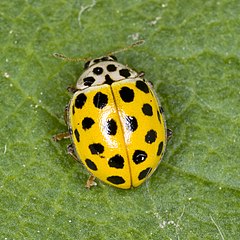Psyllobora vigintiduopunctata
| Psyllobora vigintiduopunctata | |
|---|---|

| |
| Scientific classification | |
| Domain: | Eukaryota |
| Kingdom: | Animalia |
| Phylum: | Arthropoda |
| Class: | Insecta |
| Order: | Coleoptera |
| Suborder: | Polyphaga |
| Infraorder: | Cucujiformia |
| Family: | Coccinellidae |
| Genus: | Psyllobora |
| Species: | P. vigintiduopunctata
|
| Binomial name | |
| Psyllobora vigintiduopunctata | |
Psyllobora vigintiduopunctata (often abbreviated to Psyllobora 22-punctata), the 22-spot ladybird, (earlier known as Thea vigintiduopunctata) is a common, 3–5 mm long ladybird native to Europe.[2] This species was originally discovered in Germany in 1874 on the leaves of Astragalus, consuming the hyphae of Erysiphe holosericea.[3] The elytra are yellow in colour with 22 black spots. The pronotum is yellow or white with 5 black spots.[4] Unlike most other ladybirds which feed on aphids, P. 22-punctata eats mildew — especially from umbellifers and low-growing shrubs .[5] The 22-spot ladybird is best looked for amongst low vegetation.[6]
The hemolymph of the 22-spot ladybird beetle contains a new dimeric alkaloid, psylloborine A, which has unique structural features, highlighting the species' complex chemical defenses and evolutionary adaptations. [7]

References
[edit]- ^ Linnaeus, C. 1758. Systema Naturae per regna tria naturæ, secundum classes, ordines, genera, species, cum characteribus, differentiis, synonymis, locis, Tomus I. Editio decima, reformata. Holmiæ: impensis direct. Laurentii Salvii. i–ii, 1–824 pp
- ^ G. Bradley (2006). "22-spot ladybird". UK Safari.
- ^ Karataraki, K.; Goumenaki, E.; Raftakis, E.; Goutos, D.; Kapetanakis, E. (2015-11-08). "First record of the mycophagous ladybird Psyllobora vigintiduopunctata on greenhouse cucumber plants in Crete (Greece)". Entomologia Hellenica. 24 (2): 37–41. doi:10.12681/eh.11544. ISSN 2459-3885.
- ^ Ansari Pour A, Shakarami J. Recognition of ladybird fauna (Col.: Coccinellidae) in the alfalfa fields of Khorramabad. The Journal of Animal & Plant Sciences. 2012; 22(4):939-943.
- ^ Michael Chinery (1993). Collins Field Guide: Insects of Britain and Northern Europe. 3rd edition. HarperCollins. ISBN 0-00-219918-1.
- ^ Mathias, Dilllen (April 18, 2017). "Stronger diversity effects with increased environmental stress: A study of multitrophic interactions between oak, powdery mildew and ladybirds". PLOS ONE. 12 (4): e0176104. doi:10.1371/journal.pone.0176104. PMC 5395233. PMID 28419174.
- ^ Schröder, Frank C.; Tolasch, Till (October 1998). "Psylloborine A, a new dimeric alkaloid from a ladybird beetle". Tetrahedron. 54 (40): 12243–12248. doi:10.1016/S0040-4020(98)00753-4.
 Media related to Psyllobora vigintiduopunctata at Wikimedia Commons
Media related to Psyllobora vigintiduopunctata at Wikimedia Commons Data related to Psyllobora vigintiduopunctata at Wikispecies
Data related to Psyllobora vigintiduopunctata at Wikispecies
